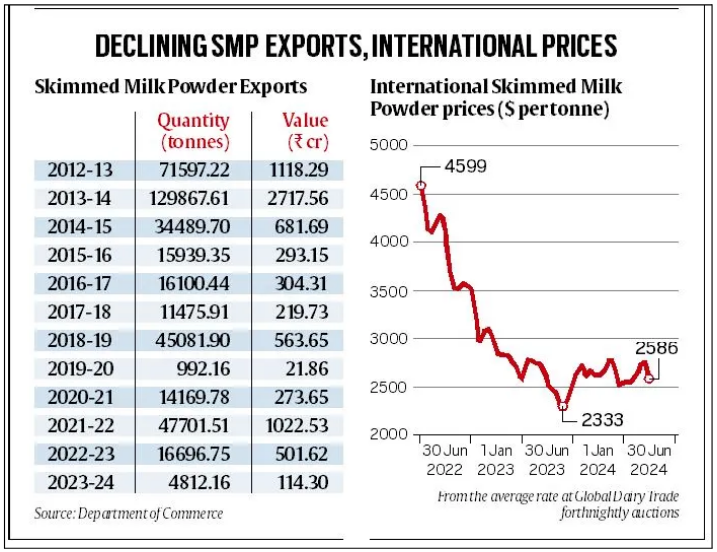News Excerpt:
Indian dairy farmers are grappling with the challenge of surplus skimmed milk powder (SMP).
About Skimmed Milk Powder:
- SMP is a dairy product made by evaporating the water from skim milk.
- Cow milk typically contains 3.5% fat and 8.5% solids-not-fat (SNF), while buffalo milk has around 6.5% fat and 9% SNF.
- Fresh milk is perishable, so dairies extract and store their solids (fat and SNF) by separating the cream and drying the skimmed milk.
- During peak production or "flush" seasons, dairies convert excess milk into butter, ghee, and SMP, which are then recombined with water to produce liquid milk in lean seasons when animal milk production drops.
- The flush season varies: in the South and Maharashtra, it spans from July to December, whereas in the North and Gujarat, it lasts from September to March, aligning with buffalo calvings.
- From 100 litres of cow milk, dairies can produce roughly 8.75 kg of SMP and 3.6 kg of ghee.
- Cooperative and private dairies have accumulated an estimated 300,000-325,000 tonnes of SMP at the beginning of the production year (July to June).
Causes of SMP Surplus:
- The surplus occurs when dairies collect more milk than usual, leading to excess production of SMP and butter/ghee without sufficient demand.
- Annually, Indian dairies produce 550,000-600,000 tonnes of SMP, with about 400,000 tonnes used during lean seasons.
- The remaining 150,000-200,000 tonnes are used in products like ice cream, biscuits, and baby formula.
- In 2023-24, continuous milk supplies, even during traditionally lean months (April-June), reduced SMP consumption for reconstitution to 250,000 tonnes, leaving dairies with surplus stocks of 300,000-325,000 tonnes at the start of the new flush season, potentially worsening the surplus.
Impact of SMP Surplus:
- The surplus has caused prices to drop, with cow SMP fetching Rs 200-210 per kg and yellow butter Rs 335-340 per kg.
- Despite a strong market for milk fat in India, especially during festive months, the excess SMP remains problematic.
- The Maharashtra government announced a Rs 5/litre subsidy for farmers, but this measure may not address the root cause of the SMP surplus.

Potential Solutions:
- Dairy traders suggest exporting the excess SMP, though global price drops make this unviable without government subsidies.
- The President of the Indian Dairy Association proposes creating a 50,000-100,000 tonne buffer stock of SMP to stabilize prices and support both producers and consumers.
- Long-term, the dairy industry needs to find markets for SMP or its components (proteins, carbohydrates, and minerals) due to increasing milk fat demand and a preference for rearing cows, which yield more milk and produce more SMP compared to buffaloes.
- Suggestions include exporting it to neighboring countries at competitive or subsidized rates or investing in technologies that separate protein from SMP for fortification or other uses on a larger scale.
- As cow milk's share in India's dairy production grows, finding a solution for the surplus SMP becomes more crucial.


